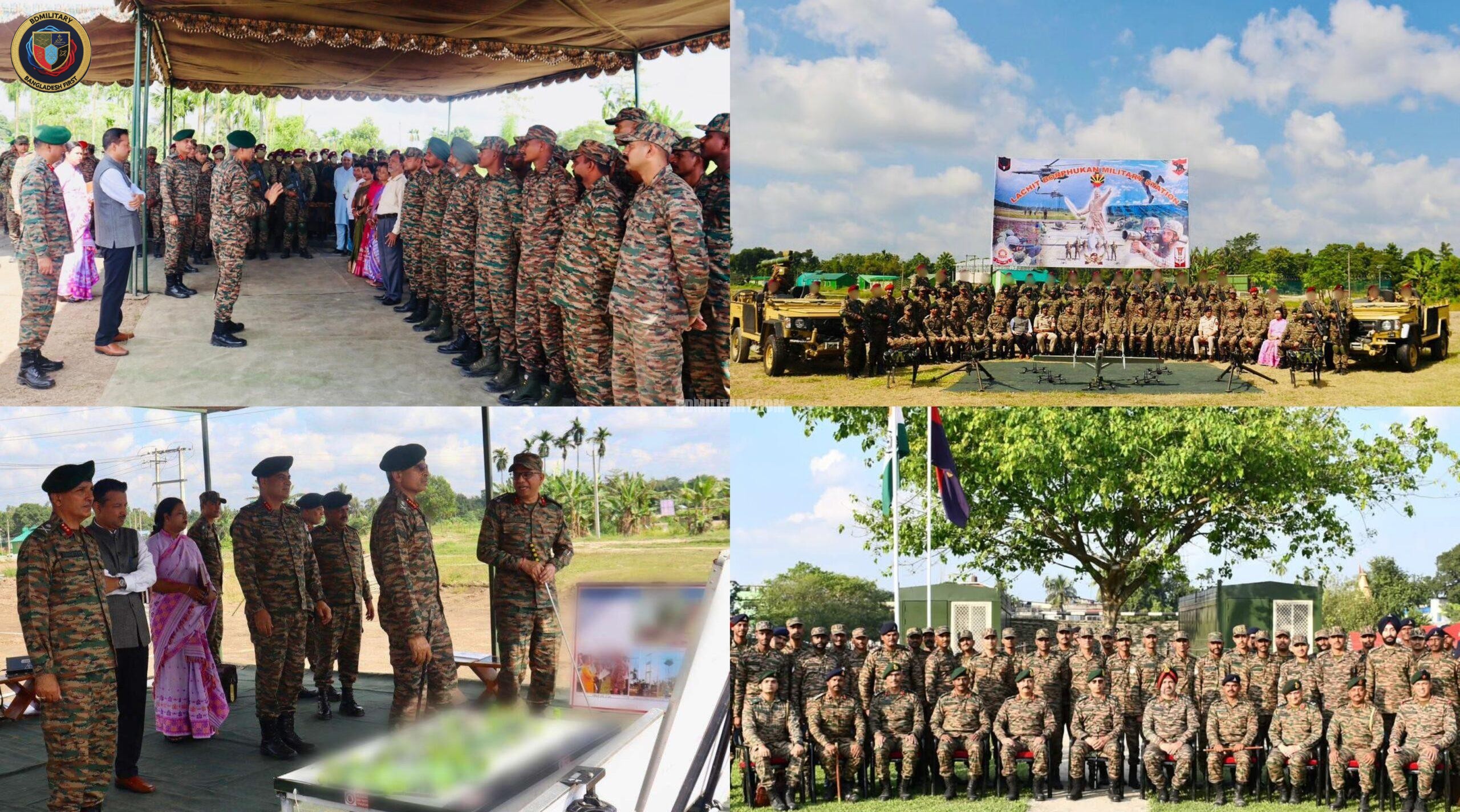India’s Eastern Command has launched an accelerated military build-up along the northern frontier with Bangladesh, responding to Dhaka’s ongoing defence modernisation projects in Rangpur Division. The Indian Army’s latest deployments, particularly near the sensitive ‘Chicken’s Neck’ corridor, mark a significant shift in posture along what has traditionally been a relatively quiet boundary.
New Military Bases Near Bangladesh Frontier
In recent months, the Indian Army has established two new military bases—one at Chopra in North Dinajpur (West Bengal) and another at Bamunigaon in Dhubri (Assam)—to reinforce its surveillance and rapid-response capacity. Both installations have been prioritised for rapid construction under “minimal timeframe” directives from Eastern Command Headquarters.
The Chopra base, situated barely a kilometre from Tetulia in Bangladesh’s Panchagarh district, sits opposite the developing Lalmonirhat airbase, where the Bangladesh Air Force (BAF) is upgrading infrastructure and installing a new air defence radar. Chopra’s proximity to the border allows India to monitor military movements in Bangladesh’s northern sector and provides a forward operating point for reinforcement of the Siliguri Corridor, often termed India’s ‘Chicken’s Neck.’
Meanwhile, the Bamunigaon base in Dhubri extends India’s operational reach into the western approaches of the corridor, covering riverine and lowland sectors where infiltration or aerial surveillance gaps might exist. The base, known as the Lachit Borphukan Military Station, was recently inspected by senior army leadership.
Eastern Command’s Heightened Activity
Lieutenant General R.C. Tiwari, Commander of India’s Eastern Army, has personally overseen the development and operational readiness of these new installations. During a visit on 6 November, he toured Chopra Defence Land, interacted with troops of the Brahmastra Corps, and commended their “unwavering zeal and professionalism” in establishing the base within record time.
He later inspected the Kishanganj Military Camp in Bihar and the Lachit Borphukan Station in Assam, reviewing internal security conditions and infrastructure development progress. In all three sites, he stressed the need for maintaining the “highest standards of operational preparedness” in view of “evolving security challenges.”
Strategic Context: The Chicken’s Neck Factor
India’s northern flank near Bangladesh borders the crucial Siliguri Corridor, a narrow 20-kilometre-wide land link connecting mainland India with its northeastern states. This region represents one of India’s most critical geostrategic vulnerabilities. Any disruption in the corridor would isolate more than 45 million residents of the northeast from the rest of the country.
Bangladesh’s ongoing modernisation of Lalmonirhat airbase—only 16 kilometres from the corridor—has been closely monitored by Indian defence planners. Reports of radar installation and a large hangar capable of hosting multiple fighter aircraft have contributed to India’s decision to harden its nearby military infrastructure.
Civil-Military Coordination and Intelligence Activity
Lt Gen Tiwari also met Chopra MLA Hamidul Rahman to highlight the importance of local cooperation in defence infrastructure development. The Eastern Command has since intensified civil–military coordination activities across West Bengal and Assam, aiming to ensure smooth logistical and intelligence operations in the region.
Unconfirmed sources further suggest that senior Indian national security officials have toured North Bengal in recent months to assess the evolving strategic landscape. Their visits reportedly coincided with intelligence-gathering operations near the Bangladesh border, particularly following the reported arrival of Chinese-origin radar equipment at Lalmonirhat.
Implications for Regional Security
The pace of India’s military consolidation near the Bangladesh border reflects both defensive caution and strategic foresight. With two new operational bases, enhanced troop presence, and infrastructure upgrades, the Indian Army appears intent on maintaining a permanent, high-readiness posture across the northern frontier.
While New Delhi officially downplays tensions with Dhaka, its actions convey growing apprehension about increased Chinese involvement in Bangladesh’s defence modernisation programmes. The proximity of advanced radar and air defence systems to the Siliguri Corridor amplifies Indian concerns regarding potential surveillance or disruption risks.
Assessment
The dual build-up—Bangladesh’s modernisation of Lalmonirhat and India’s simultaneous reinforcement at Chopra and Bamunigaon—marks a new phase in sub-regional military positioning. For India, the priority remains clear: ensuring the security of the Chicken’s Neck corridor through pre-emptive infrastructure expansion and operational readiness.
Bangladesh, however, is unlikely to cede the observational advantage. The new Indian installations lie well within the coverage envelope of Dhaka’s upgraded air surveillance radar network and its growing suite of precision indirect-fire systems. As a result, Bangladesh will likely maintain comprehensive surveillance over Chopra, Bamunigaon and adjacent forward operating areas, with the capability to detect, track and, if necessary, target movements originating from these bases. The prospect of India employing them as forward launch pads for operations against Bangladesh would therefore be visible to — and contested by — Bangladesh’s integrated air-picture and precision-fire assets, reducing the chance of surprise and raising the risks associated with any offensive option.
India’s creation of these frontier bases is also seen as a strategic signal intended to exert political and military pressure on Dhaka. However, the Bangladesh Armed Forces remain focused on their routine modernisation under the Forces Goal 2030 roadmap, continuing infrastructure and capability upgrades in line with long-term national objectives rather than being swayed by Indian geopolitical pressure tactics.
Whether this strategic escalation remains a posture of deterrence or evolves into a sustained regional rivalry will depend on how effectively both sides manage perception, communication, and diplomacy in the months ahead.
Annex A — Indian Frontier Bases
| Base name | Location (State/District) | Reported / Assessed Types of Assets & Infrastructure | Operator / Primary Formations |
|---|---|---|---|
| Chopra Defence Land | Chopra, North Dinajpur (West Bengal) | Rapidly established forward operating base; troop accommodation and cantonment facilities; forward surveillance posts and observation platforms; logistics and supply nodes for sustainment; forward command post and communications nodes. Proximity to Tetulia (Panchagarh, Bangladesh) gives tactical observation value. | Indian Army — Eastern Command (Brahmastra Corps reported as the initial deploying formation). Units from 111 Area and supporting elements likely to rotate through. |
| Lachit Borphukan Military Station (Bamunigaon) | Bamunigaon, Dhubri (Assam) | Riverine access and river-crossing support infrastructure; troop accommodation and staging areas; internal security and rapid reaction facilities; infrastructure works to support mobility in lowland and riverine sectors. | Indian Army — Eastern Command. Inspected by Eastern Army leadership; Trinetra Division and local formations provide area oversight. |
| Kishanganj Military Camp | Kishanganj (Bihar) | Staging and logistical hub for operations affecting the Siliguri Corridor; training and readiness facilities; communications and intelligence liaison nodes; rapid-reinforcement assembly areas. | Indian Army — Eastern Command; 111 Area and Trinetra Division elements have responsibility for approaches to the Siliguri Corridor. |
Note: The details above are compiled from official Eastern Command releases, regional reporting and on-the-ground assessments. Asset lists are reported or assessed items and may change as formations are brought to full operational capability. Where precise ordnance or unit types were not publicly disclosed, entries are described at the infrastructure and capability level (e.g., “staging”, “surveillance posts”, “logistics nodes”) to avoid speculative micro-claims.

Ayesha Farid is a regional security specialist focusing on South Asia, with over a decade of experience analysing inter-state tensions, cross-border insurgency, and regional power dynamics. She has worked with leading policy think tanks and academic institutions, offering nuanced insights into the complex security challenges shaping the subcontinent. Ayesha’s expertise spans military doctrines, border disputes, and regional cooperation frameworks, making her a vital contributor to BDMilitary’s coverage of South Asian strategic affairs. She leads the Geopolitics & Diplomacy section at BDMilitary. Ayesha holds a dual master’s degree — a Master in International Relations from the IE School of Politics, Economics & Global Affairs, Spain, and a Master of Public Policy from the Munk School of Global Affairs, University of Toronto, Canada — combining deep academic insight with practical policy expertise.


